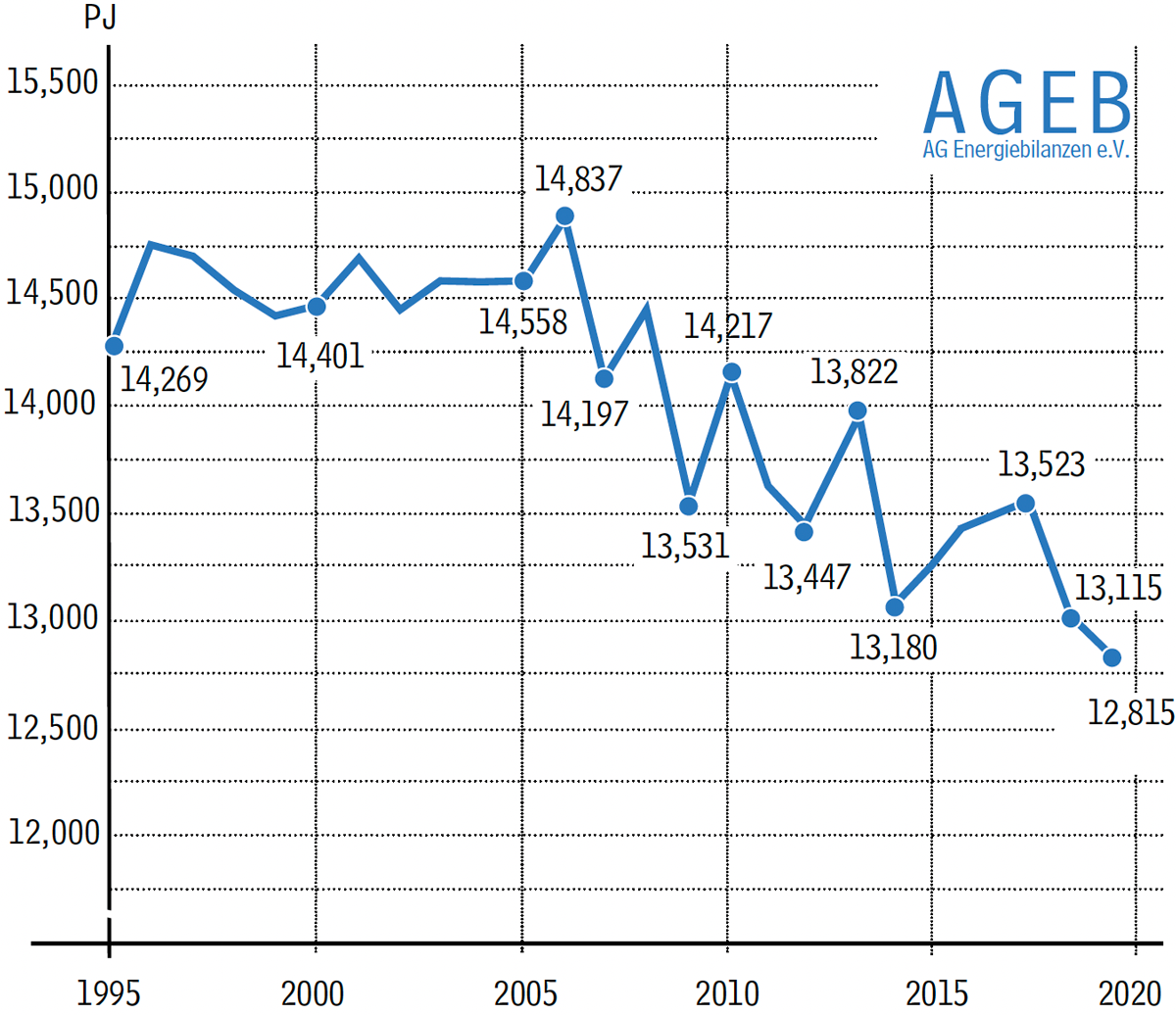Berlin/Bergheim (December 18, 2019) – According to preliminary calculations conducted by the Arbeitsgemeinschaft Energiebilanzen (AG Energiebilanzen) – Working Group on Energy Balances (Energy Balances Group), Germany’s energy consumption peaked at 12,815 petajoules (PJ), or 437.3 million tons of coal equivalent (Mtce), in 2019. This translates into a decline of 2.3 percent when compared to the previous year.
According to the AG Energiebilanzen, the decline in consumption was a result of further improvements in energy efficiency, substitutions in the energy mix as well as a decline in industrial energy consumption due to the overall economic situation. The slightly cooler weather and the growth in population had a consumption-enhancing effect. All told, though, the consumption-enhancing factors were significantly weaker than the consumption-reducing ones. According to the AG Energiebilanzen, and if adjusted by the weather impact as well as by changes in stock levels, energy consumption would have even decreased by more than 3 percent. Since the consumption of coals experienced a particularly strong decline in 2019 while renewables were able to increase their share even further, the AG Energiebilanzen anticipates a noticeable decline in CO₂ emissions (also adjusted by the temperature effects and changes in stock levels) of well above 7 percent, which equals more than 50 million tons.
The total consumption of mineral oil in 2019 was 1.7 percent higher than the previous year. Sales of diesel fuel and gasoline as well as aviation fuel exhibited a slight increase. Light fuel oil recorded a significant increase in sales of 17.4 percent. Due to the economic situation, supplies of naphtha for the chemical industry decreased by about 8 percent.
Germany’s natural gas consumption went up by 3.6 percent. In addition to the higher demand for heating in the cooler months of spring, this upturn was, above all, due to the increased use of natural gas in power plants.
Consumption of hard coal decreased by a total of 20.5 percent and reached a historic low point. Both the generation of power and heat experienced declines of more than a third which was due to the fact that more power was generated from renewables and natural gas. The steel industry reduced its hard coal use by almost 4 percent. For the first time in quite a long time, the steel industry was the most important sales sector for this energy carrier.
Lignite consumption went down by 20.7 percent in 2019. Due to the transfer of additional power plant units into their standby mode for backup purposes, reduced extraction volumes in the open-pit mine Hambach, a larger number of power plant revisions when compared to the previous year as well as increased power generation from renewables, supplies to lignite-fired power plants experienced a significant downswing. Consumption of lignite, thus, decreased for the seventh year in a row.
Compared to the previous year, nuclear energy exhibited a slight reduction in power generation amounting to about 1 percent. By the end of the year, another nuclear power plant (Philippsburg) will go offline as scheduled.
Renewables enhanced their contribution to the total energy consumption by 4 percent in 2019. Wind energy increased its share by 15 percent. Hydro power grew by 4 percent. Solar energy went up only slightly by 1 percent. Biomass, which accounted for more than 50 percent of the entire volume in the renewables sector, recorded a plus of 2 percent.
According to preliminary figures, Germany’s electricity exchange balance with its neighboring countries turned out to be lower in 2019 than in the previous years. The electricity volume which flowed from foreign countries into Germany increased. In return, electricity flows from Germany into its neighboring countries decreased significantly. This development was caused by shifts in the European power generation infrastructure due to increased CO₂ prices as well as lower gas prices.
Compared to the previous year, the contributions of the diverse energy sources to the national energy mix have shifted further in 2019: Fossil energy experienced an overall decline so that the energy supply in Germany was able to reduce its carbon intensity even further. A characteristic feature, however, continues to be the broad energy mix. Oil and gas accounted for more than 60 percent of the domestic energy consumption. Hard coal and lignite collectively encompassed approximately 18 percent of the consumption. Renewables increased their share to nearly 15 percent.
Substantial Drop in Energy Consumption in 2019
Development of Primary Energy Consumption in Germany in 2019
Estimated Changes in Percent — Total 12,815 PJ or 437.3 Mtce

Berlin/Bergheim – In 2019, primary energy consumption in Germany fell more than 2 percent below the previous year’s level. According to preliminary calculations conducted by the Arbeitsgemeinschaft Energiebilanzen (AG Energiebilanzen) – Working Group on Energy Balances (Energy Balances Group), consumption peaked at 12,815 petajoules (PJ), which translates into 437.3 million tons of coal equivalent (Mtce).
Source: Arbeitsgemeinschaft Energiebilanzen
Shifts in the German Energy Mix
Structure of Primary Energy Consumption in Germany in 2019
Total Volume 12,815 PJ or 437.3 Mtce
Proportions in Percent (Previous Year in Parentheses)

Berlin/Bergheim – The contributions of the diverse energy sources to the national energy mix have shifted in favor of renewables as well as natural gas in 2019. Mineral oil was able to augment its share as well. In contrast, significant declines were recorded for hard coal and lignite. The German energy supply, thus, reduced its carbon intensity even further in 2019.
A characteristic feature, however, continues to be the broad energy mix.
Source: Arbeitsgemeinschaft Energiebilanzen
Primary Energy Consumption in Germany
1995 — 2019
in Petajoules (PJ)

Berlin/Bergheim – According to preliminary estimates conducted by the Arbeitsgemeinschaft Energiebilanzen (AG Energiebilanzen) – Working Group on Energy Balances (Energy Balances Group), energy consumption in Germany in 2019 peaked at 12,815 petajoules (PJ) which translates into 437.3 million tons of coal equivalent (Mtce). It, thus, fell 2.3 percent below the level which had been reached in 2018.
Source: Arbeitsgemeinschaft Energiebilanzen
